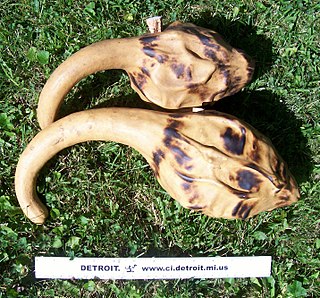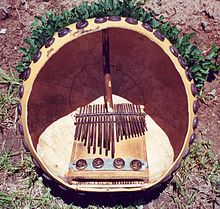
The xylophone is a musical instrument in the percussion family that consists of wooden bars struck by mallets. Like the glockenspiel, the xylophone essentially consists of a set of tuned wooden keys arranged in the fashion of the keyboard of a piano. Each bar is an idiophone tuned to a pitch of a musical scale, whether pentatonic or heptatonic in the case of many African and Asian instruments, diatonic in many western children's instruments, or chromatic for orchestral use.

Mbira are a family of musical instruments, traditional to the Shona people of Zimbabwe. They consist of a wooden board with attached staggered metal tines, played by holding the instrument in the hands and plucking the tines with the thumbs, the right forefinger, and sometimes the left forefinger. Musicologists classify it as a lamellaphone, part of the plucked idiophone family of musical instruments. In Eastern and Southern Africa, there are many kinds of mbira, often accompanied by the hosho, a percussion instrument. It is often an important instrument played at religious ceremonies, weddings, and other social gatherings. The "Art of crafting and playing Mbira/Sansi, the finger-plucking traditional musical instrument in Malawi and Zimbabwe" was added to the UNESCO Representative List of the Intangible Cultural Heritage of Humanity in 2020.
Given the vastness of the African continent, its music is diverse, with regions and nations having many distinct musical traditions. African music includes the genres amapiano, jùjú, fuji, afrobeat, highlife, Congolese rumba, soukous, ndombolo, makossa, kizomba, and others. African music also uses a large variety of instruments across the continent. The music and dance of the African diaspora, formed to varying degrees on African musical traditions, include American music like Dixieland jazz, blues, jazz, and many Caribbean genres, such as calypso and soca. Latin American music genres such as cumbia, salsa music, son cubano, rumba, conga, bomba, samba and zouk were founded on the music of enslaved Africans, and have in turn influenced African popular music.

Zimbabwean music is heavily reliant on the use of instruments such as the mbira, Ngoma drums and hosho. Their music symbolizes much more than a simple rhythm, as the folk and pop style styled music was used as a symbol of hope for Zimbabweans looking to gain independence from Rhodesia. Music has played a significant role in the history of Zimbabwe, from a vital role in the traditional Bira ceremony used to call on ancestral spirits, to protest songs during the struggle for independence. The community in Zimbabwe used music to voice their resistance to their oppression, as one of the only weapons they had available to fight back with. In the eighties, the Music of Zimbabwe was at the center of the African Music scene thanks to genres such as Sungura and Jit. However, several performers were banned by state TV and radio leading to the closing of several music venues.

The hosho are Zimbabwean musical instruments consisting of a pair of maranka (mapudzi) gourds with seeds. They are used as major instruments in many traditional Shona music genres, such as in mbira ensembles and in mhande. They typically contain hota seeds inside them. Before the hota seeds are added, the hosho is boiled in salted water and the inside is scraped out with a corncob, newspaper plug, or woven wire. Removing the debris inside the hosho allows for a more sharp and percussive tone.

Oliver "Tuku" Mtukudzi was a Zimbabwean musician, businessman, philanthropist, human rights activist and UNICEF Goodwill Ambassador for Southern Africa Region.
Shona music is the music of the Shona people of Zimbabwe. There are several different types of traditional Shona music including mbira, singing, hosho and drumming. Very often, this music will be accompanied by dancing, and participation by the audience. In Shona music, there is little distinction between the performer and the audience, both are often actively involved in the music-making, and both are important in the religious ceremonies where Shona music is often heard.
Ephat Mujuru (1950–2001), was a Zimbabwean musician, one of the 20th century's finest players of the mbira, a traditional instrument of the Shona ethnic group of Zimbabwe.

The Shona people are a Bantu ethnic group native to Southern Africa, primarily living in Zimbabwe where they form the majority of the population, as well as Mozambique, South Africa, and a worldwide diaspora. There are five major Shona language/dialect clusters: Manyika, Karanga, Zezuru, Korekore, and Ndau.

Stella Chiweshe was a Zimbabwean musician. She was known internationally for her singing and playing of the mbira dzavadzimu, a traditional instrument of the Shona people of Zimbabwe. She was one of few female players, and learned to play from 1966 to 1969, when other women did not.

Ngoma are musical instruments used by certain Bantu populations of Africa. Ngoma is derived from the Kongo word for "drum". Different Bantu-inhabited regions have their own traditions of percussion, with different names for their instruments. In Kikongo, "ngoma" is used by extension to signify specific dances, social occasions, and rhythms. In Swahili, Ngoma music is used to describe music, dance, instruments including the drums, and events together as a joint cultural practice..
Chirikure Chirikure, is a Zimbabwean poet, songwriter, and writer. He is a graduate of the University of Zimbabwe and an Honorary Fellow of University of Iowa, US. He worked with one of Zimbabwe's leading publishing houses as an editor/publisher for 17 years, until 2002. He now runs a literary agency and also works as a performance poet, cultural consultant and translator.

Hugh Travers Tracey was an English ethnomusicologist. He and his wife collected and archived music from Southern and Central Africa. From the 1920s through the 1970s, Tracey made over 35,000 recordings of African folk music. He popularized the mbira internationally under the name kalimba.

The International Library of African Music (ILAM) is an organization dedicated to the preservation and study of African music. Seated in Grahamstown, South Africa, ILAM is attached to the Music Department at Rhodes University and coordinates its Ethnomusicology Programme which offers undergraduate and post-graduate degrees in Ethnomusicology that include training in performance of African music. ILAM, as the largest repository of indigenous African music, is particularly known for its study of the lamellophone mbira of Zimbabwe and Mozambique, as well as the Chopi people's Timbila, a variant of the marimba from southern Mozambique.
Chartwell Shorayi Dutiro was a Zimbabwean musician, who started playing mbira when he was four years old at the protected village, Kagande; about two hours drive from Harare, where his family was moved by the Salvation Army missionaries during the Chimurenga. Even though the missionaries had banned traditional music, he learned to play from his brother and other village elders. His mother also encouraged him through her singing of traditional songs.

Forward Kwenda is a mbira performer from Zimbabwe. He was born in the rural Buhera area of Manicaland. As a young boy, Forward was interested in traditional dance and the recitation of ancient poetry. At the age of 10, he began to play ngoma (drums) and hosho for his mother's 'gombwe (rain-making) spirit'. He was given the name "Forward" for his involvement in many activities and his performances for guerrilla forces during the Rhodesian Bush War.

Dancing in Zimbabwe is an important aspect of the Zimbabwean culture, tradition, spirituality and history. There are many dances that reflect the culture of the people, although the dances may have changed throughout the years. Ethnic diversity is also a key factor in influencing the dances of the Zimbabwean culture. These dances are self-reflective, for the entire community because all music and dance are communal events. Dance to Zimbabweans is a very spiritual, powerful tool that carries on traditions, and chronicles the important events of their history and culture.
Queen Marimba is a folk hero whose accomplishments have become part of the folklore of Africa. As is customary in most African cultures she is considered to be a god and was one of the immortals. She led the Akamba tribe in East Africa in very ancient times across the Ukambani plains in present day Kenya, stretching across the Kilimanjaro plains in present day Tanzania. There has been scant research done on her and presently the most notable source for information on her life comes from the writings of Vusa'mazulu Credo Mutwa. He asserts in his book; Indaba My Children, that she was the mother of the Akamba people at the time when they were getting to know their Maasai neighbours. Various renditions of his book have been published since the late 60's, including "My People, My Africa", "Indaba My Children" and "Africa Is My Witness."

Tendayi (Samaita) Gahamadze is a Zimbabwean artist and songwriter.
Mhande is a traditional performance practiced among the Shona people, involving music and dance. It is a vital element of the mutoro ceremony, an annual rain ritual of the Karanga.













